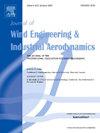Transformer-based full-track simulation of tropical cyclones
IF 4.9
2区 工程技术
Q1 ENGINEERING, CIVIL
Journal of Wind Engineering and Industrial Aerodynamics
Pub Date : 2025-07-25
DOI:10.1016/j.jweia.2025.106176
引用次数: 0
Abstract
Full-track simulation of tropical cyclones (TCs) is the most widely adopted approach to estimate wind speeds for structure design and TC hazard assessment. This study presents two Transformer-based models, TCformer and eTCformer, for TC full-track simulation. TCformer is designed to directly simulate the entire TC track, aligning with the statistical approach, while eTCformer incorporates large-scale environmental factors such as wind velocity components and vertical wind shear into the Transformer framework, corresponding to the statistical-dynamical approach. The primary advantages of the two DL models lie in their efficiency and flexibility, particularly their ability to capture complex nonlinear interactions among arbitrary variables. Comparative analysis demonstrates that Transformer-based models outperform traditional methods across multiple metrics, exhibiting enhanced robustness and better preservation of spatial correlation patterns, especially in intensity simulations. Furthermore, the accuracy of virtual TC landfall simulations and their evaluated impacts on key coastal cities also underscores the Transformer-based models potential to advance typhoon risk analysis. Overall, the proposed models demonstrate potential as robust tools for reliable TC sample modeling, as well as enhanced understanding of behavioral patterns and improved assessment of both climate change impacts and disaster risks.
基于变压器的热带气旋全轨迹模拟
热带气旋全轨迹模拟是结构设计和危害评估中应用最广泛的风速估计方法。本文提出了两种基于变压器的模型,TCformer和eTCformer,用于TC全轨道仿真。TCformer直接模拟整个TC轨迹,符合统计方法,而eTCformer将风速分量、垂直风切变等大尺度环境因素纳入Transformer框架,符合统计-动力学方法。这两种深度学习模型的主要优点在于它们的效率和灵活性,特别是它们能够捕获任意变量之间复杂的非线性相互作用。对比分析表明,基于transformer的模型在多个指标上优于传统方法,表现出更强的鲁棒性和更好的空间相关模式保存,特别是在强度模拟中。此外,虚拟TC登陆模拟的准确性及其对主要沿海城市的评估影响也强调了基于变压器的模型在推进台风风险分析方面的潜力。总的来说,所提出的模型显示出作为可靠的TC样本建模的强大工具的潜力,以及增强对行为模式的理解和改进对气候变化影响和灾害风险的评估。
本文章由计算机程序翻译,如有差异,请以英文原文为准。
求助全文
约1分钟内获得全文
求助全文
来源期刊
CiteScore
8.90
自引率
22.90%
发文量
306
审稿时长
4.4 months
期刊介绍:
The objective of the journal is to provide a means for the publication and interchange of information, on an international basis, on all those aspects of wind engineering that are included in the activities of the International Association for Wind Engineering http://www.iawe.org/. These are: social and economic impact of wind effects; wind characteristics and structure, local wind environments, wind loads and structural response, diffusion, pollutant dispersion and matter transport, wind effects on building heat loss and ventilation, wind effects on transport systems, aerodynamic aspects of wind energy generation, and codification of wind effects.
Papers on these subjects describing full-scale measurements, wind-tunnel simulation studies, computational or theoretical methods are published, as well as papers dealing with the development of techniques and apparatus for wind engineering experiments.

 求助内容:
求助内容: 应助结果提醒方式:
应助结果提醒方式:


